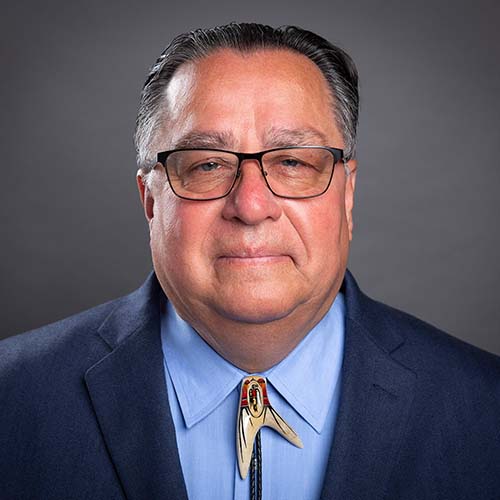- Details
- By Cecilia Nowell
Western groups lose federal grants for urgent restoration and conservation projects.
On Sept. 23, Emily Rees was planting thousands of seedlings of New Mexico vervain, a purple wildflower beloved by pollinators, on the plateau above the Rio Grande Gorge near Taos when she received a phone call telling her to stop.
Editor's Note: This article was originally published by High Country News. Used with permission. All rights reserved.
Two hundred miles south, Tino Mendietta was collecting coneflower seeds on Bureau of Land Management land near Roswell when his phone lit up with the same news. His field crew packed up and headed back to the office to process as much data as they could on the seeds they’d been able to gather, knowing they wouldn’t be allowed to return the following day.
That morning, Rees and Medietta’s employer — the Institute for Applied Ecology, a conservation nonprofit focused on protecting native seeds, pollinators and habitats across the Western U.S. — received 30 federal award cancellation notices from agencies overseen by the Department of the Interior.
 The purple vervain flower grows near Las Cruces, New Mexico. Staff from the Institute for Applied Ecology planted seedlings of the plant in New Mexico to aid pollinators, but the grant to do so was canceled by the Trump administration in mid-September. Joseph Yaroch / CC via Flickr
The purple vervain flower grows near Las Cruces, New Mexico. Staff from the Institute for Applied Ecology planted seedlings of the plant in New Mexico to aid pollinators, but the grant to do so was canceled by the Trump administration in mid-September. Joseph Yaroch / CC via Flickr
As part of its pledge to shrink the size of the federal government, the Trump administration has proposed cutting more than 2,000 jobs from the Interior Department along with billions of dollars of funding for climate-related projects. While many of those funding cuts have occurred within the federal government, others have trickled down to conservation organizations, including the Institute for Applied Ecology — altering their relationship with federal partners, restricting their conservation work and halting their partnerships with private growers. The IAE is one of at least six Western conservation groups currently experiencing such cuts.
THE IAE WAS NOTIFIED that 30 of its federal grants had been canceled “over the course of maybe an hour and a half” on Sept. 23, said Katy Silber, assistant director of the organization’s Southwest office. Each notice said that the grant was being terminated immediately because it “no longer effectuates the priorities” of the agency. The institute asked if it could adjust its projects to better align with agency priorities and, if not, whether it could appeal the decision. But the Interior Department replied that there was no appeals process.
The grants covered work with the Bureau of Land Management, U.S. Fish and Wildlife Service, National Park Service and U.S. Geological Survey. In some cases, the funding in question had been approved as recently as August.
That same day, the Mid Klamath Watershed Council received notice that seven of its federal grants had been terminated, amounting to a $2.1 million loss, while the Lomakatsi Restoration Project received cancellation notices for eight of its federal agreements, and the Institute for Bird Populations lost funding for nine of its projects.
Federal grants and agreements typically account for 70% to 80% of the IAE’s annual operating budget. The cancellation notices it received this fall eliminated more than $3,500,000 that had already been appropriated for the institute.
“The only public acknowledgement of these terminations came from a tweet from (Interior) Secretary (Doug) Burgum. That linked to an article in the Daily Caller,” said Keith Norris, the institute’s executive director.
The Daily Caller article claimed “that the Department of the Interior (DOI) cancelled 79 grants to environmental organizations on Tuesday, totaling around $14 million” to “several groups that also happened to proclaim diversity, equity and inclusion (DEI) values.” Those groups included the Bird Conservancy of the Rockies and CalTrout as well as the IAE. The Department of Government Efficiency retweeted Secretary Burgum’s link to the article, quoting language from the IAE’s website regarding its work in diverse communities. In a statement, the institute responded that “if such a commitment is indeed the government’s motive behind these cancellation notices, then we strongly disagree, and we resolutely stand by our values.”
In response to a request for comment from High Country News, an Interior Department spokesperson referred HCN “to the Secretary’s X post” and included a link to it.
“We work really hard to support our communities regardless of any political affiliation,” said Will Harling, restoration director at the Mid Klamath Watershed Council, adding that the group’s projects, including wildfire prevention and fisheries protection, “are meant to serve our entire community.”
THE GRANT TERMINATIONS will impact IAE’s conservation work — protecting several Western pollinators and their habitats by growing sagebrush to assist recovery from wildfires, for example, as well as tracking and restoring at-risk species and preventing the spread of invasive species.
“We’ve got tens of thousands of sagebrush that have been planted or that have been grown as little seedlings that were due to be part of some BLM restoration efforts. That has now been lost,” said Norris.
 The Institute for Applied Ecology is growing of sagebrush as part of restoration efforts, but recent cuts by the Trump administration have terminated IAE grants to grow them. Shown here is sagebrush being grown at the Wyoming Honor Farm in 2024. Bella Norton/Institute for Applied Ecology
The Institute for Applied Ecology is growing of sagebrush as part of restoration efforts, but recent cuts by the Trump administration have terminated IAE grants to grow them. Shown here is sagebrush being grown at the Wyoming Honor Farm in 2024. Bella Norton/Institute for Applied Ecology
In Oregon, IAE conservation research program director Scott Harris is overseeing work to protect the Taylor’s checkerspot butterfly, based on a model the institute successfully used for the Fender’s blue butterfly, the only butterfly in the United States to be downlisted from the Endangered Species Act. But funding for that project, as well as another to monitor the invasive emerald ash borer, has been cut. The IAE had been responsible for setting up traps that detected the first ash borer on BLM land, Harris said. “If emerald ash borer comes through, and it’s pretty likely it will, it’s going to kill most of the ash trees,” which are vital to riparian ecosystems.
In New Mexico, where the IAE had been monitoring 12 rare plants on BLM land affected by oil and gas development, cuts to that project forced the group to lay off three crew members, said Silber. The institute had also just begun work on a project to plant native grasses in the Chihuahuan Desert for wintering grassland birds. Now, however, “the seed is just sitting in our warehouse,” said Silber, who added that it won’t remain viable for more than a few years. “We had a contractor who was going to do that seeding, and so they’ve lost $30,000 and we had less than a month’s notice to cancel that,” she said, noting that that the federal grant cuts have had “ripple effects on the species, on the contractors, on our staff.”
AS A RESULT of the federal grant cancellations, the IAE terminated contracts with a dozen farmers in New Mexico, Arizona and Colorado. The over $1 million in funding would have gone directly to farmers like Janice Lucero (Isleta Pueblo), who had prepared her fields at Cotton Blossom Gardens for work that will no longer be done. Because the grant cancellations came in the middle of the growing season, Silber said, “They’ve already done all of the field preparations and there were plants that were literally in a truck being delivered to those growers. And we had to tell them, ‘Sorry, you’ve done all this work.’”
The institute was also forced to lay off four staff members and five seasonal crew members, Silber said, adding that they are generally “young conservationists” like Mendietta, 34, who was leading the Roswell crew when the cuts came through, and Bronwyn Taylor, 31, who has had to pick up additional shifts at a restaurant because it’s already too late in the season to join a new crew.
Despite the layoffs, Mendietta and Taylor both attended the IAE’s annual Pollinator Palooza on Oct. 10. Under the cloudy sky of a looming thunderstorm, institute researchers and crew members listened to presentations on Jemez Mountain pollinators and native bee monitoring in the Sevilleta National Wildlife Refuge, delivered in a garage attached to the institute’s Santa Fe office.
“We’re still trying to figure out how to best close down some of these terminated projects in a way that doesn’t result in lost investment in conservation — or minimizes the lost investment,” said Norris. “We’re dealing with living things, and so some of these terminations have left some living things stranded.”
“Some of these terminations have left some living things stranded.”
In some cases, the institute has found volunteers or new partners to help finish planting seeds or pay out contracts. But “nobody can replace the federal government in this space,” he said.
“Effective conservation across the landscape requires the federal government’s involvement and participation, and that’s what at least one of the things the Department of the Interior, I would argue, is set up to do.”
Note: This story was updated to replace an image of sagebrush seedlings with one specifically associated with the Institute for Applied Ecology’s program.
This story is part of High Country News’ Conservation Beyond Boundaries project, which is supported by the BAND Foundation.
Help us defend tribal sovereignty.
At Native News Online, our mission is rooted in telling the stories that strengthen sovereignty and uplift Indigenous voices — not just at year’s end, but every single day.
Because of your generosity last year, we were able to keep our reporters on the ground in tribal communities, at national gatherings and in the halls of Congress — covering the issues that matter most to Indian Country: sovereignty, culture, education, health and economic opportunity.
That support sustained us through a tough year in 2025. Now, as we look to the year ahead, we need your help right now to ensure warrior journalism remains strong — reporting that defends tribal sovereignty, amplifies Native truth, and holds power accountable.
 The stakes couldn't be higher. Your support keeps Native voices heard, Native stories told and Native sovereignty defended.
The stakes couldn't be higher. Your support keeps Native voices heard, Native stories told and Native sovereignty defended.
Stand with Warrior Journalism today.
Levi Rickert (Potawatomi), Editor & Publisher
















